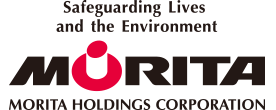- HOME
- Sustainability
- S: Social Initiatives
- Diversity Management
- Career Continuation Support System
Career Continuation Support System
In the hope that employees should be able to actively continue their careers with job satisfaction even during periods of child-raising, nursing care, or long-term recuperation, the Morita Group has made efforts to institutionalize systems that give consideration to employees' ease of working and taking leave and also systems that do not disadvantageously treat such periods in evaluation/promotion.
Career 100 System
This is a system under which an employee who has taken any maternity leave, child-raising leave, or nursing care leave during a period of evaluation (six months) is evaluated in terms of his/her achievements during the period on a six-point scale with the rate of his/her work attendance during the period deemed to be 100%.
Example: How to evaluate an employee who has worked four months before taking leave.

The shorter period at work by two months "does not" lead to lower performance. Instead, the employee is evaluated based 100% on the results he/she has produced during that period.
Modified Promotion Requirements for Employees Who Have Taken Parental/Nursing Leave
This system is used to make a fair decision in an evaluation for promotion of an employee who has taken child-raising or nursing care leave.
One of the requirements for promotion normally requires "a certain level of results in the annual evaluations for the immediately previous two years." However, for employees who have taken child-raising or nursing care leave during that period, whether such an employee meets the requirements for promotion is judged "on the basis of the results of the last two annual evaluations held immediately before the leave."
Staggered Commuting System (Earlier/Later Work Hours System)
In this system, an employee who has a child 12 years old or younger (till the end of March when the child finishes the sixth grade) is allowed to flexibly shift his/her work start/end hours by up to an hour, within a period between a month and a year each time.
System of Short Working Hours for Child-Raising
While relevant laws and regulations prescribe that the applicable age of each child in relation to short working hours is "under the age of three years," our system extends it to "until the completion of the third grade of elementary education." The daily working hours may be shortened by a maximum of two hours in units of 30 minutes.
Special Leave for School Event Participation
This system provides employees who have a grade-school child with maximum five-day special paid leave a year for their participation in various school events. This benefit will be available until the child graduates from a grade school.
Maternity/Child-Raising Leave Interview System
This is a system under which interviews are conducted with a leave applicant and his/her superior in each stage of before leave, before work reinstatement, after work reinstatement, etc. with consideration given to privacy, in order to provide necessary explanations on relevant systems.
Nursing Care Leave System
This system grants each applicable employee a length of 20 days of nursing care leave (paid leave) per family member requiring nursing care, which is far greater than the statutorily required number of days (five days).
Nursing Care Extension System
In addition to the statutory length of nursing care leave (93 days), this system allows an extension of the leave period up to 12 months in total from the commencement of leave. When taken, an extended leave period may be divided into up to 12 separate periods.
Such an extended leave period is compensated by a salary equivalent to a nursing care leave benefit.
System of Shorter Working Days for Nursing Care
Under this system, a specific day (one day) of the week is designated as a non-working day to be used for provision of nursing care to the relevant family member.
Hospital Visit Leave System
This system grants each applicable employee an annual length of 24 days of leave for hospital visits in the case where the employee has suffered from a disease requiring long-term treatment (such as cancer) and is in need of treatment even after all of his/her paid leave and injury/sickness leave has been used up.
